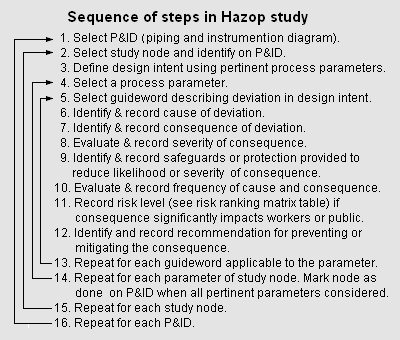User:Milton Beychok/Sandbox
A Hazard and Operability Study (HAZOP) is a simple, structured methodology for identifying, evaluating and prioritizing potential hazardous occurrences in an existing process facility or a proposed new facility.[1][2][3] The HAZOP methodology is a safety analysis that uses and encourages imaginative thinking (or brainstorming) and was first developed by Imperial Chemical Industries (ICI), a British chemical company. It is performed by a multi-disciplinary HAZOP team and entails the use of guide words to stimulate the brainstorming. For a proposed new process facility (such as a petroleum refinery, natural gas processing plant or chemical plant), a HAZOP may require many weeks to perform.
Although the HAZOP methodology was originally developed to study chemical process facilities, it has been extended to other types of facilities and complex operations.
There are many other hazard evaluation (HE) techniques, some of which are simpler than a HAZOP and some of which are more complex. For example, the Checklist and What-If methodologies are simpler than a HAZOP, and the Failure Mode Effects and Analysis (FMEA) and Fault Tree methodologies are more complex. In the United States as well as some other nations, governmental regulations require some type of hazard evaluation be performed for certain, specified types of existing or proposed new process facilities.
What a HAZOP is not
A HAZOP is not an method to determine how far one can go in physically removing or mitigating all risks nor is it a method for defining engineering or procedural solutions for eliminating sources of risk.
Most importantly, it is not a guarantee that adverse consequences will not occur.
The HAZOP team
| Name | Alternative | Role |
|---|---|---|
| Study leader | Chairman | someone experienced in Hazop but not directly involved in the design, to ensure that the method is followed carefully |
| Recorder | Secretary or scribe | to ensure that problems are documented and recommendations passed on |
| Designer | (or representative of the team which has designed the process) | To explain any design details or provide further information |
| User | (or representative of those who will use it) | To consider it in use and question its operability, and the effect of deviations |
| Specialist | (or specialists) | someone with relevant technical knowledge |
| Maintainer | (if appropriate) | someone concerned with maintenance of the process. |
References
- ↑ Center for Process Safety, AIChE (2008). Guidelines for Hazard Evaluation Procedures, 3rd Edition. Wiley-American Institute of Chemical Engineers. ISBN 0-471-97815-9.
- ↑ Trevor Kletz (2006). Hazop and Hazan, 4th Edition. Institution of Chemical Engineers. ISBN 0-85295-506-5.
- ↑ Hazard & Operability Studies (HAZOPS) Excellent explanation of HAZOPs by a HAZOP software company
| Severity | Liklihood | |||
|---|---|---|---|---|
| Frequent | Probable | Occasional | Remote | |
| Major | Unacceptable | Unacceptable | Unacceptable | High |
| Moderate | Unacceptable | High | High | Medium |
| Small | High | Medium | Low | Low |
| Insignificant | Medium | Low | Low | low |
| Frequent = Once or more per year Probable = Between once or more per year and once per 10 years Occasional = Between once per 10 years and once per 30 years Remote = less than once per 30 years | ||||
| Term | Definition |
|---|---|
| Hazard | A source, situation, event, circumstance or condition with the potential to cause harm, including ill health, injury or death, production losses, or damage to the environment. |
| Study nodes (or process sections) |
Section of the process equipment with definite boundaries (for example, the piping from a process vessel to a pump) within which process parameters are investigated to determine the effect of deviations from the design intention and the potential of a hazard being created in that section. |
| Parameter | A physical or chemical property involved in a study node, including items such as temperature, pressure, pH, concentration, reaction or volume. |
| Deviation | Departures from the design intention that are discovered by systematically applying the pertinent guide words applicable for each study node. |
| Design intention | Definition of how the study node is expected to operate in the absence of deviations from the process design. |
| Guide words (or guidewords) |
Simple words used to qualify the the design intention and to guide and stimulate the brainstorming process for identifying potential process hazards. |
| Safeguards (or protection systems) |
Administrative controls (such as operating manuals and work procedures) or engineered systems designed to prevent deviations or to mitigate the consequences of deviations. |
| Guide word Parameter |
More | Less | None | Reverse | Part of | As well as | Other than |
|---|---|---|---|---|---|---|---|
| Flow | x | x | x | x | x | x | x |
| Temperature | x | x | |||||
| Pressure | x | x | x | x | |||
| Level | x | x | x | ||||
| Volume | x | x | x | x | |||
| Mixing | x | x | x | ||||
| Composition | x | ||||||
| Reaction | x | x | x | x | x | ||
| pH | x | x |


